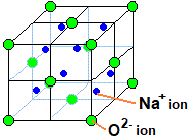
The structure of \[{\text{N}}{{\text{a}}_{\text{2}}}{\text{O}}\] crystal is:
(A) \[{\text{CsCl}}\]type
(B) \[{\text{NaCl}}\]type
(C) \[{\text{KCl}}\]type
(D) Anti-fluorite
Answer
215.1k+ views
Hint: Sodium oxide has a chemical formula \[{\text{N}}{{\text{a}}_{\text{2}}}{\text{O}}{\text{.}}\] The main use of this chemical is in ceramics and in the formation of glasses. It is a base anhydride of sodium hydroxide \[{\text{(NaOH)}}{\text{.}}\] This means that when water is added to sodium oxide, sodium hydroxide is formed. The reaction is as follows –
\[N{a_2}O{\text{ }} + {\text{ }}{H_2}O{\text{ }} \to {\text{ }}2NaOH\]
Complete step by step answer:
Sodium oxide or \[{\text{N}}{{\text{a}}_{\text{2}}}{\text{O}}\] possesses the structure of anti-fluorite. Sodium ions are smaller in size than the oxide ions so they go to the voids. Moreover, the number of sodium ions present is twice that of the oxide ions so all the tetrahedral voids get filled by sodium ions. The oxide ions are larger in size so they occupy the face and corners of the lattice. Therefore, the structure formed is all the oxide ions occupy the face and corners while the sodium ions occupy the tetrahedral voids.

The anti-fluorite structure is derived from fluorite structure by interchanging the positive and negative positions in the lattice crystal.
Hence, the correct answer is (D) i.e., anti-fluorite.
Note: Sodium oxide is widely used in the manufacturing of ceramic and glass products. Also, sodium oxide is insoluble in water, but when added to water, it would result in the formation of sodium hydroxide.
\[N{a_2}O{\text{ }} + {\text{ }}{H_2}O{\text{ }} \to {\text{ }}2NaOH\]
Complete step by step answer:
Sodium oxide or \[{\text{N}}{{\text{a}}_{\text{2}}}{\text{O}}\] possesses the structure of anti-fluorite. Sodium ions are smaller in size than the oxide ions so they go to the voids. Moreover, the number of sodium ions present is twice that of the oxide ions so all the tetrahedral voids get filled by sodium ions. The oxide ions are larger in size so they occupy the face and corners of the lattice. Therefore, the structure formed is all the oxide ions occupy the face and corners while the sodium ions occupy the tetrahedral voids.

The anti-fluorite structure is derived from fluorite structure by interchanging the positive and negative positions in the lattice crystal.
Hence, the correct answer is (D) i.e., anti-fluorite.
Note: Sodium oxide is widely used in the manufacturing of ceramic and glass products. Also, sodium oxide is insoluble in water, but when added to water, it would result in the formation of sodium hydroxide.
Recently Updated Pages
Chemical Equation - Important Concepts and Tips for JEE

JEE Main 2022 (July 29th Shift 1) Chemistry Question Paper with Answer Key

Conduction, Transfer of Energy Important Concepts and Tips for JEE

JEE Analytical Method of Vector Addition Important Concepts and Tips

Atomic Size - Important Concepts and Tips for JEE

JEE Main 2022 (June 29th Shift 1) Maths Question Paper with Answer Key

Trending doubts
JEE Main 2026: Application Form Open, Exam Dates, Syllabus, Eligibility & Question Papers

JEE Main Correction Window 2026 Session 1 Dates Announced - Edit Form Details, Dates and Link

Equation of Trajectory in Projectile Motion: Derivation & Proof

JEE Main 2026 Application Login: Direct Link, Registration, Form Fill, and Steps

Hybridisation in Chemistry – Concept, Types & Applications

Angle of Deviation in a Prism – Formula, Diagram & Applications

Other Pages
NCERT Solutions For Class 12 Chemistry Chapter 1 Solutions - 2025-26

NCERT Solutions for Class 12 Chemistry Chapter Chapter 7 Alcohol Phenol and Ether

NCERT Solutions ForClass 12 Chemistry Chapter Chapter 8 Aldehydes Ketones And Carboxylic Acids

JEE Advanced Marks vs Ranks 2025: Understanding Category-wise Qualifying Marks and Previous Year Cut-offs

Haloalkanes and Haloarenes Class 12 Chemistry Chapter 6 CBSE Notes - 2025-26

Solutions Class 12 Chemistry Chapter 1 CBSE Notes - 2025-26




